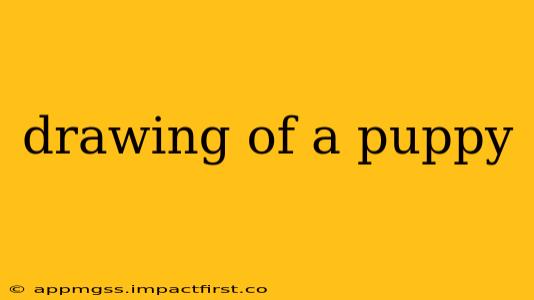Drawing a Puppy: A Guide for Beginners and Beyond
Drawing a puppy can be a delightful and rewarding experience, whether you're a seasoned artist or just starting out. This guide will walk you through the process, from basic shapes to adding those adorable puppy details. We'll cover different styles and techniques to help you capture the unique charm of your canine subject.
What materials do I need to draw a puppy?
This is a frequently asked question, and the answer depends on your preferred style and level of detail. For a basic sketch, you'll only need a pencil and paper. However, for more detailed drawings, you might consider:
- Pencils: A range of pencils (e.g., 2H, HB, 2B, 4B) will allow you to vary line weight and shading.
- Eraser: A kneaded eraser is ideal for lifting graphite without damaging the paper.
- Paper: Smooth drawing paper works well for detailed drawings, while textured paper can add interesting effects.
- Optional: Colored pencils, markers, or paints for adding color and depth.
How do I draw a simple puppy?
Let's start with a simplified approach. We'll build our puppy using basic shapes:
- Head: Begin with a circle for the head.
- Body: Add an oval for the body, slightly overlapping the circle.
- Legs: Attach four small ovals or cylinders for the legs, connecting them to the body.
- Ears: Draw two floppy triangles for the ears, attaching them to the top of the head.
- Tail: Add a curved line for the tail, extending from the body.
- Facial Features: Add two small circles for the eyes, a small triangle for the nose, and a curved line for the mouth.
Once you have these basic shapes, you can refine them, adding curves and details to make your puppy look more realistic or stylized. Experiment with different poses and expressions.
What are some tips for drawing realistic puppy fur?
Drawing realistic fur can be challenging, but here are some techniques:
- Hatching and Cross-Hatching: Use short, parallel lines (hatching) and then layer intersecting lines (cross-hatch) to build up texture and depth. Vary the pressure on your pencil to create different values.
- Stippling: Create texture by using tiny dots to indicate the direction and density of the fur.
- Blending: Gently blend the pencil strokes to create smooth transitions between light and shadow. This helps create a soft, fluffy look for the fur.
How do I draw a puppy from a photo?
Using a reference photo is a great way to improve your accuracy and understanding of anatomy. Here's how to approach it:
- Study the Photo: Carefully observe the proportions, shapes, and the overall structure of the puppy.
- Break Down the Form: Just like our simple puppy example, try to simplify the shapes and forms to basic geometric structures.
- Light and Shadow: Pay close attention to the light source and how it affects the shading on the puppy's fur.
- Details: Once you have the basic structure down, gradually add more details like fur texture, eye color, and individual features.
How can I draw a cartoon puppy?
Cartoon puppies offer a lot of creative freedom. You can exaggerate features, use simpler shapes, and add personality through expressions. Don't be afraid to experiment with different styles and have fun!
What are some resources for learning to draw puppies?
Numerous online tutorials, books, and courses are available to help you improve your puppy-drawing skills. YouTube is a great resource for video tutorials, showcasing various techniques and styles.
By following these tips and practicing regularly, you'll be well on your way to creating adorable and expressive puppy drawings. Remember, practice is key, and don't be afraid to experiment and find your own style!
